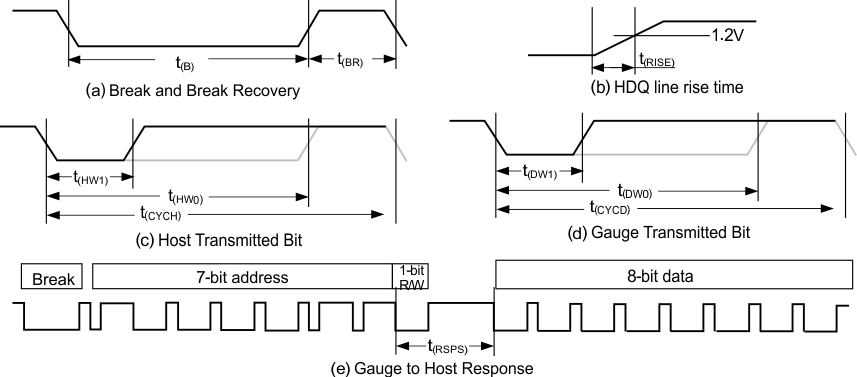JAJSFE4B May 2015 – May 2018
PRODUCTION DATA.
- 1 特長
- 2 アプリケーション
- 3 概要
- 4 改訂履歴
- 5 Device Comparison Table
- 6 Pin Configuration and Functions
-
7 Specifications
- 7.1 Absolute Maximum Ratings
- 7.2 ESD Ratings
- 7.3 Recommended Operating Conditions
- 7.4 Thermal Information
- 7.5 Supply Current
- 7.6 Digital Input and Output DC Characteristics
- 7.7 Power-On Reset
- 7.8 2.5-V LDO Regulator
- 7.9 Internal Clock Oscillators
- 7.10 Integrating ADC (Coulomb Counter) Characteristics
- 7.11 ADC (Temperature and Cell Voltage) Characteristics
- 7.12 Data Flash Memory Characteristics
- 7.13 HDQ Communication Timing Characteristics
- 7.14 I2C-Compatible Interface Timing Characteristics
- 7.15 Typical Characteristics
-
8 Detailed Description
- 8.1 Overview
- 8.2 Functional Block Diagram
- 8.3
Feature Description
- 8.3.1 Fuel Gauging
- 8.3.2 Impedance Track Variables
- 8.3.3 Power Control
- 8.3.4 Autocalibration
- 8.3.5 Communications
- 8.4 Device Functional Modes
- 8.5 Programming
- 8.6 Register Maps
- 9 Application and Implementation
- 10Power Supply Recommendations
- 11Layout
- 12デバイスおよびドキュメントのサポート
- 13メカニカル、パッケージ、および注文情報
7.14 I2C-Compatible Interface Timing Characteristics
TA = –40°C to 85°C, CREG = 0.47 μF, 2.45 V < VREGIN = VBAT < 5.5 V; typical values at TA = 25°C and VREGIN = VBAT = 3.6 V (unless otherwise noted)| PARAMETER | TEST CONDITIONS | MIN | NOM | MAX | UNIT | |
|---|---|---|---|---|---|---|
| tr | SCL/SDA rise time | 300 | ns | |||
| tf | SCL/SDA fall time | 300 | ns | |||
| tw(H) | SCL pulse width (high) | 600 | ns | |||
| tw(L) | SCL pulse width (low) | 1.3 | μs | |||
| tsu(STA) | Setup for repeated start | 600 | ns | |||
| td(STA) | Start to first falling edge of SCL | 600 | ns | |||
| tsu(DAT) | Data setup time | 1000 | ns | |||
| th(DAT) | Data hold time | 0 | ns | |||
| tsu(STOP) | Setup time for stop | 600 | ns | |||
| tBUF | Bus free time between stop and start | 66 | μs | |||
| fSCL | Clock frequency (1) | 400 | kHz | |||
(1) If the clock frequency (fSCL) is > 100 kHz, use 1-byte write commands for proper operation. All other transactions types are supported at 400 kHz. (Refer to I2C Interface.)
 Figure 1. HDQ Timing Diagrams
Figure 1. HDQ Timing Diagrams  Figure 2. I2C-Compatible Interface Timing Diagrams
Figure 2. I2C-Compatible Interface Timing Diagrams